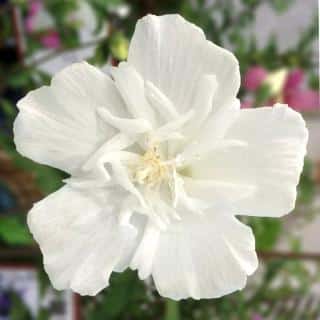

Rose of Sharon, sometimes hyphenated to Rose-of-Sharon, is a delightful summer-blooming garden shrub.
Rose of Sharon key facts
Name – Hibiscus syriacus
Family – Mallow family (Malvaceae)
Type – summer shrub
Foliage – deciduous
Flowering – May through Oct/Nov
Exposure – full sun, tolerates part sun
This blooming shrub has been listed as noteworthy by ancient Greek men of science. Its beauty led it to be cultivated in gardens of Mesopotamia and the Renaissance saw it spread across Europe.
Rose of Sharon is native to semi-tropical regions (Southern China, Northern India). It’s used to getting a lot of light.
In many places, it thrives along roads and highways where it brings beauty to daily commutes.
Some Rose of Sharon varieties are hardy down to 20° F (-5 or -6°C), these can be planted in the ground in most parts. Non-hardy varieties will have to be grown in containers.
Many of the wildly attractive blooming Rose of Sharon varieties are tropical hibiscus hybrids and aren’t quite as hardy. Container growing makes it easy to bring them indoors for the winter, where you can store them in a greenhouse or lean-in.
The constant summer blooming drains soil nutrients fast, so repotting is an important step to ensure abundant blooming. For larger pots, consider topdressing with rich compost.
Rose of Sharon is a plant that likes water and doesn’t cope well with extended drought, especially for younger specimens.
Rose of Sharon is rather sensitive to water that is excessively loaded with salts and minerals. It’s best to collect rainwater in the garden to give it pure, mineral-free water!
When grown indoors in pots, it helps to provide moisture to the air around the plant. This helps recreate moist environments that some tropical Rose of Sharon varieties are native to.
Rose of Sharon, while not a tree, can grow impressively large. It’s a bit like jasmine in that respect, reaching sizes of 6 feet across and 12 feet tall (almost 2 meters wide and 4 meters tall).
When well settled in, in a suitable environment, Rose of Sharon will grow multiple trunks and turn into a dense flowering thicket in under 5 years. Pruning is important to contain this and keep a nice, clustered bearing.
Pruning in spring is the best time. It ensures your shrub won’t suffer from frost at the wounds, while still giving plenty of time for new wood to grow. Blooms appear on new wood.
It’s also possible to work with Rose of Sharon into espalier shapes. This is nice and rather uncommon for Rose of Sharon, so pruning it into palmate patterns or along a wall will make for a surprising and appealing impact!
When used as a flowered hedge, this particular type of Hibiscus will only provide privacy when diligently pruned to branch out a lot. It’s a good solution to separate portions of a garden without completely shutting each out.
Some Rose of Sharon varieties are infertile, which means seed pods don’t fully form. But most varieties actually go to seed very successfully, and quickly spread seeds around them when the pods burst open.

Like the passion flower, the Buddha’s Hand citrus, and the Judas tree among others, Rose of Sharon shows how culture and quest for meaning are intimately connected to every day life. Every gardener can remember a moment of awe and wonder at a marvelous flower, a sprouting seedling, or a favorite plant seemingly resurrecting from the dead! (Less favorite plants, too. Weeds are good at this resurrection thing…)
Rose of Sharon can be used in hedges, as a standalone and it can also be added to a sun-endowed shrub bed. The more sun it gets, the more flowers it will bear!
Diseases and pests are almost never a problem to the Rose of Sharon Hibiscus.
Try sprouting some of the seeds and let them reach blooming age. In many cases, flowers will grow in new colors and shapes compared to the mother plant!
Your comment is awaiting moderation.